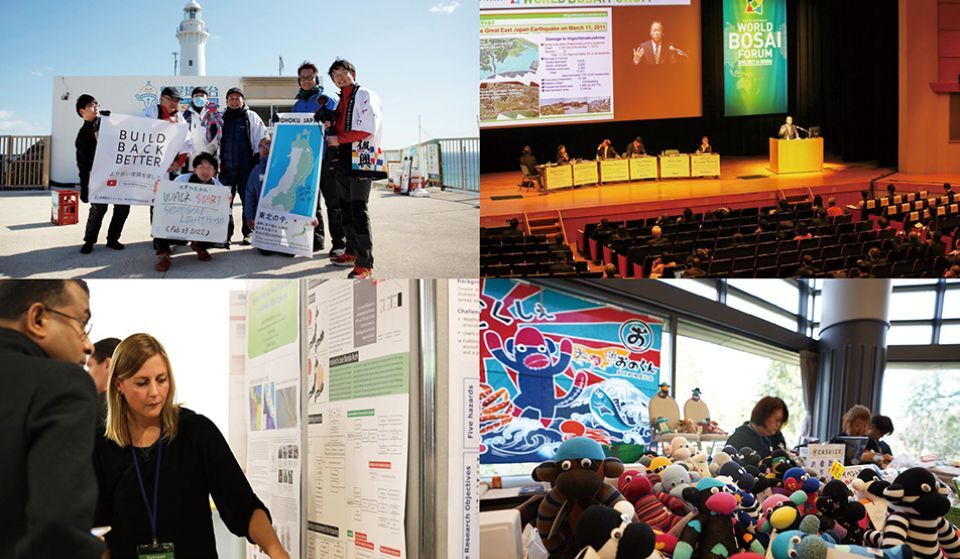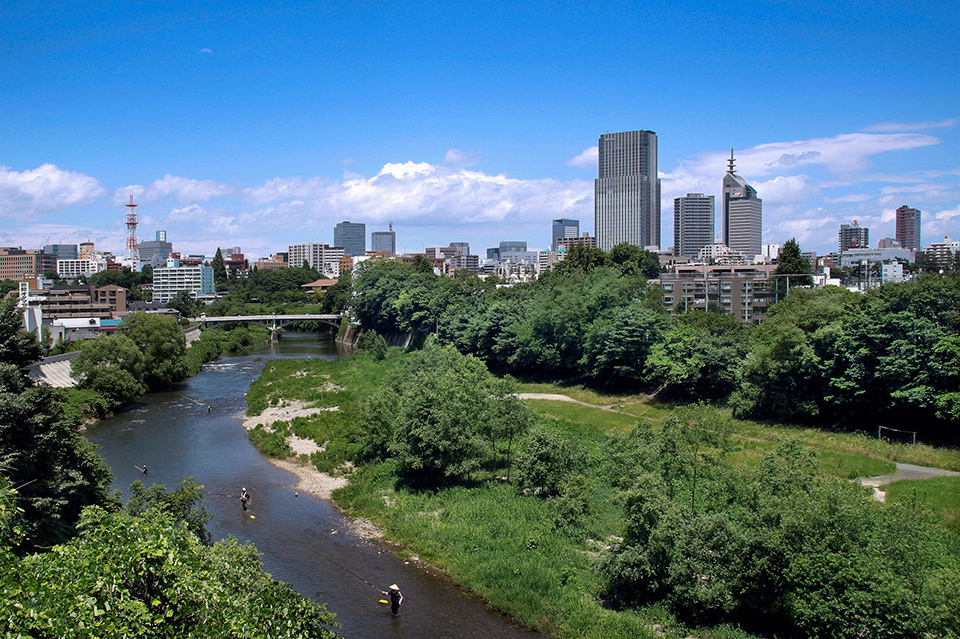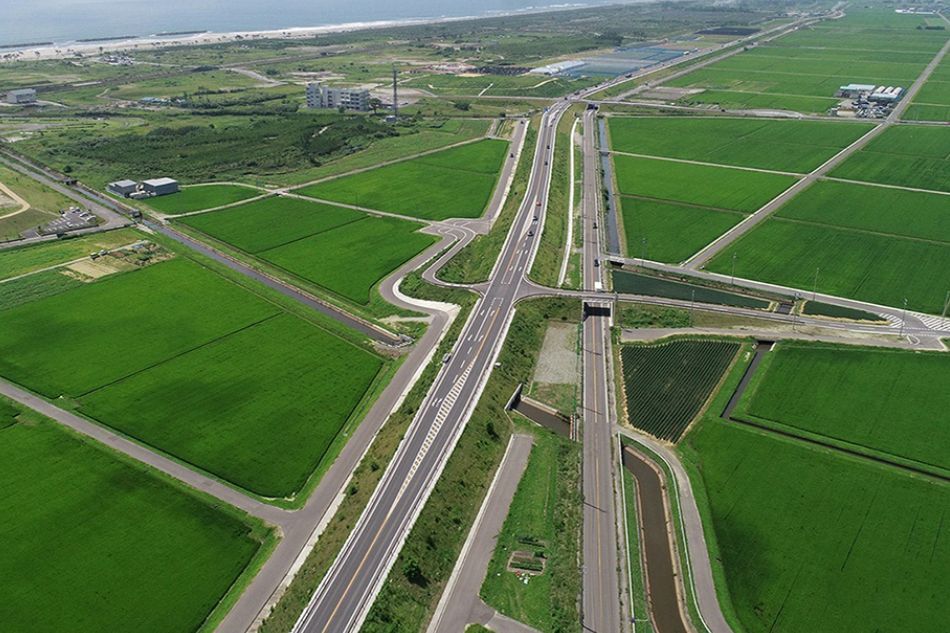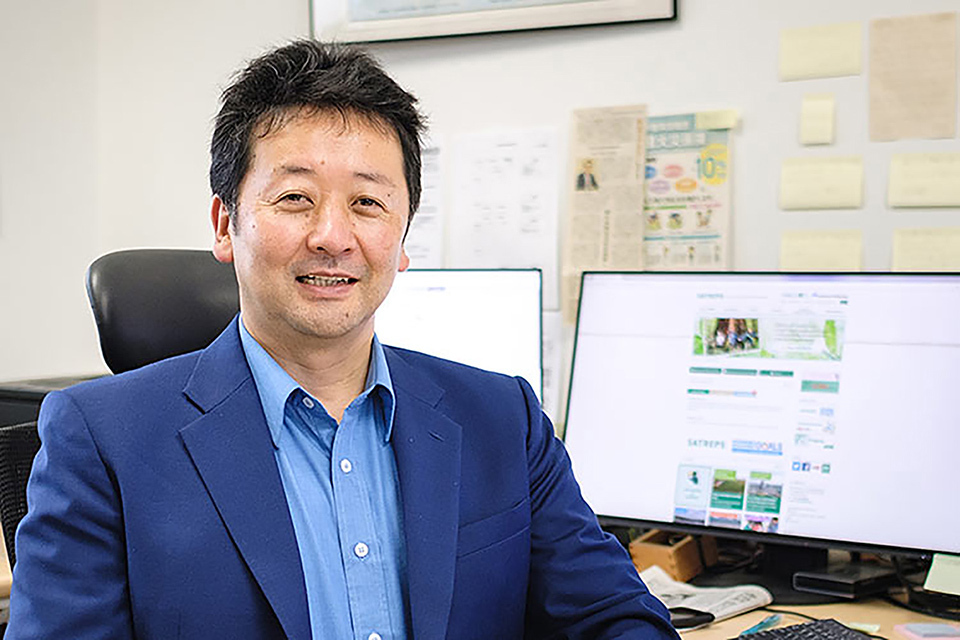The World BOSAI Forum, an international conference on bosai—a Japanese term referring to countermeasures against natural disasters at all stages, from prevention and mitigation to post-disaster management and reconstruction—will be held in March in Sendai, one of the cities struck by the Great East Japan Earthquake. We look at the forum’s focus, rooted in the lessons learned from that disaster, and its message to the world.

The World BOSAI Forum—to be held from March 10 to 12, 2023—has taken place about once every two years since 2017. People from some 40 countries and regions around the world will gather to discuss various bosai solutions. Use of unique Tohoku recovery mascots (bottom right), a walking tour of the disaster-affected areas in 2021(top left), and other such friendly touches full of local color have added to the attraction of the forum in the past. THE WORLD BOSAI FORUM
Japan has been afflicted throughout history by natural disasters, creating original terms related to these events—such as tsunami and sabō—that are now understood globally. And recently, another Japanese word—bosai—has emerged as an important concept drawing attention. “Bosai has a wide range of meanings, from disaster prevention and mitigation to post-disaster management and reconstruction. There’s no word like it in English,” says Professor ONO Yuichi of Tohoku University’s International Research Institute of Disaster Science (IRIDeS). “It essentially means building systems that are resilient to disasters. To that end, not only do we need to organize post-disaster responses, but we should also prepare ourselves in advance from multiple perspectives. With the recent increase in natural disasters worldwide, we want to spread the concept of bosai internationally.”
The third ever World BOSAI Forum will be held in March in Sendai City, Miyagi Prefecture, to deepen discussion on bosai and further share the concept with the world. The forum will bring together individuals and organizations from across the globe—including researchers, companies, NGOs, and others—to discuss a broad range of bosai-related topics, from the latest technological advancements to climate change impacts. But with its focus on practical knowledge and solutions, the forum differs from typical academic conferences. The reason for such a focus lies in the lessons learned from the Great East Japan Earthquake that struck many parts of the Tohoku region, including Sendai City, in 2011. “Japan has been collecting disaster data and developing countermeasures since the early days, including publishing an annual White Paper on Disaster Management since 1963. Its countermeasures and level of knowledge are considered among the best in the world. However, despite all those efforts, the extensive damage caused by the giant earthquake and tsunami of 2011 came as an enormous shock to those of us working in the field. It was a turning point for Japan, making us concentrate more on actual practice,” says Ono, the founder of the forum.

Sendai—the host city of the World BOSAI Forum—is rich in greenery, with a population of 1.09 million in Miyagi Prefecture. The city has been frequently afflicted throughout its history by natural disasters, from typhoons to floods and tsunami. AFLO

Following the March 2011 earthquake, disaster-affected areas have introduced a “multiple-defense” system that combines several methods to mitigate disaster risks. For example, Sendai, in addition to building embankments and planting windbreaks in coastal areas, has constructed elevated roads that can function as embankments. CITY OF SENDAI
Left: Sendai—the host city of the World BOSAI Forum—is rich in greenery, with a population of 1.09 million in Miyagi Prefecture. The city has been frequently afflicted throughout its history by natural disasters, from typhoons to floods and tsunami. AFLO
Right: Following the March 2011 earthquake, disaster-affected areas have introduced a “multiple-defense” system that combines several methods to mitigate disaster risks. For example, Sendai, in addition to building embankments and planting windbreaks in coastal areas, has constructed elevated roads that can function as embankments. CITY OF SENDAI
Since the earthquake, efforts have accelerated in the Tohoku region that are leading international movements toward bolstering disaster risk reduction. In 2012, Tohoku University in Sendai established IRIDeS with the aim of creating an academic framework for studying practical disaster management utilizing bosai. Sendai was chosen to host the Third UN World Conference on Disaster Risk Reduction in 2015, which adopted the Sendai Framework for Disaster Risk Reduction 2015–2030 as the first such agreement to set specific global targets. To achieve those targets, IRIDeS established the Global Centre for Disaster Statistics. Along with monitoring the disaster damage statistics of countries around the world, the center attempts to propose investments needed in risk reduction tailored to each country. The World BOSAI Forum evaluates the progress of the Sendai Framework and makes concrete proposals.

After earning his doctorate in the United States specializing in tornado disaster research, Professor ONO Yuichi of Tohoku University’s International Research Institute of Disaster Science was engaged in designing international disaster risk reduction policies at UN institutions. His experience in 2011 as a volunteer in one of the areas affected by the Great East Japan Earthquake convinced him to move back to Japan and dedicate the rest of his life to bosai efforts, continuing to work on improving disaster readiness internationally. THE WORLD BOSAI FORUM
Another distinguishing feature of the forum is its openness to citizen participation. Anyone who registers can join the forum, which is designed to be people friendly and, in the past, has included presentations on stockpiling food and related activities by students, as well as a walking tour of disaster-affected areas. The lessons of the 2011 disaster are very much alive within such offerings as well. Ono, who volunteered his time and efforts after the disaster in order to interview affected residents, found that while many of those on the coast had evacuated to safety thanks to their heightened awareness, quite a few living more inland had hesitated to evacuate and thus failed to escape in time. To prevent such a tragedy from ever occurring again, continuous efforts must be made to raise public awareness—that is the strong belief incorporated within the forum.
Ono believes that the fact of having organized the forum cooperatively with local citizens helps deliver a more powerful message on the necessity of bosai, from the perspective of those directly involved, to countries that need to prepare countermeasures themselves. “Nobody else in the world should have to go through the same horrible experiences that we did—such strong thoughts will be conveyed via the words of those who personally bore the effects of the disaster. We hope to continue sending out such a message, grounded in the perspective of individual citizens, and realize a disaster-resilient world.”






























